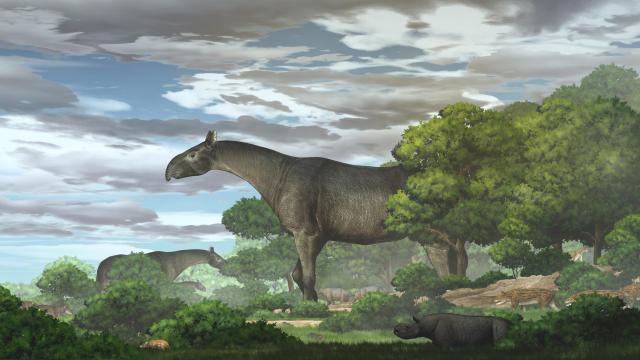Giant rhinos are among the largest mammals to have ever walked this great Earth, and a newly discovered species that lived in northwest China some 25 million years ago is revealing just how magnificent these creatures were.
Gigantism is a biological trait typically associated with dinosaurs, but natural selection has produced some fairly huge mammals as well. In fact, the largest animal of all time, the blue whale, is a mammal. In terms of large terrestrial mammals, Steppe mammoths were pretty big, as were giant ground sloths, but giant rhinos were likely the biggest.
Several genera of giant rhinos are known, among them Paraceratherium. These extinct hornless rhinos lived primarily in Asia, with fossils spread throughout China, Mongolia, Kazakhstan, and Pakistan. The evolutionary history of giant rhinos is a bit vague, however, and paleontologists have struggled to discern their exact proportions owing to an abundance of incomplete fossils. What is clear, however, is that these mammals were very large.
This group can now claim a new member, Paraceratherium linxiaense, as reported in a study published today in Communications Biology. Paleontologist Tao Deng, from the Institute of Vertebrate Paleontology and Paleoanthropology at the Chinese Academy of Sciences, led the research.

The fossilized bones of this species were pulled from the Linxia Basin in the northwestern Gansu province of China. The partial remains of two individuals were recovered, namely a skull, mandible, and associated atlas (first cervical vertebra of the spine) from one specimen, and an axis and two thoracic vertebrae of another individual. The fossils were found in Late Oligocene deposits dated at 26.5 million years old.
One of the fossils is a “fantastically well-preserved skull with jaws and neck vertebra — so well preserved that it tells you it was preserved and buried quickly,” Lawrence Flynn, an evolutionary biologist at Harvard University and a co-author of the study, explained in an email. “It provides thorough anatomical information to define a new species distinct from the other closely related giant rhinos.”
Analysis of these fossils took place from December 2016 to February 2017. The team made laser scans of the specimens to build a digital 3D model, which allowed them to characterise the animals and compare them to other giant rhinos.
The evidence pointed to an entirely new species. Compared to other Paraceratherium, this animal featured a slender skull, a short nose trunk, a long neck, and a deeper nasal cavity. This giant rhino “had no horn,” Deng explained in an email. “Its small upper first incisors and deep nasal notch indicates a longer prehensile nose trunk, similar to that of the tapir,” while its large body size, as evidenced by its large 1.16 m-long head, distinguishes it from other species of Paraceratherium, he added.
Extrapolating from the partial remains, Deng estimates a weight of 21 tonnes, “similar to the total weight of four largest individuals of the modern African elephant,” he said. P. linxiaense stood 5 metres at the shoulders, and its body measured 8 metres long.
The giant rhino’s long legs were good for running, Deng said, and its head could reach a height of 7 metres, allowing it to “browse the leaves of tree tops.” The giant rhino’s prehensile nose trunk would’ve been “extremely useful to wrap around branches as they stripped off the leaves with their front teeth,” Deng explained. Its tusk-like incisors were probably used to break twigs, strip bark, and bend higher branches, he added. Like other Paraceratherium, this giant rhino lived in open woodlands.
Interestingly, P. linxiaense bears a resemblance to giant rhinos that once lived in what is now Pakistan. The new research suggests giant rhinos travelled from northwest China through the Tibetan region, which led them to the Indian-Pakistani subcontinent. This is exciting for both an evolutionary and geological standpoint, as it suggests the Tibetan region “likely hosted some areas with low elevation,” possibly under 2,000 metres during the Oligocene, “and the lineage of giant rhinos could have dispersed freely along the eastern coast of the [ancient] Tethys Ocean and perhaps through some lowlands of this region,” the paleontologists wrote in the study.
Though they may look somewhat alike, modern rhinos are in fact not descended from Paraceratherium or other giant rhinos. Instead, both groups can claim a common ancestor that lived some 50 million years ago.
